PRESIDENT OFFICE REGIONAL ADMNISTRATION AND LOCAL GOVERNMENT
SECONDARY EXAMINATION SERIES
COMPETENCE BASED ASSEMENT
ENGLISH LANGUAGE
FORM FOUR
MID-TERM-2 – AUG/SEPT 2024
TIME 3:00 HRS
INSTRUCTIONS
- This paper consists of sections A, B and C with a total of twelve questions
- Answer All questions in Sections A and B and three (3) questions from section C
- Mind your Handwriting and Neatness.
SECTION A (15 Marks)
Answer all questions in this section
- For each of the items (i) - (x), choose the most correct option from among the given alternatives and write its letter beside the item in answer sheet provided.
- Madam Silvia told Calvin to say the following statement loudly; " I wish you wish,but if you wish the witch wishes, I won't wish the wish you wish to wish." Thisstatement is known as?
A. a brainstormin
B. a pronunciation test
C. a creative composition
D. a tongue twister
E. a quiz
- A man with two beautiful wives Jane and Hasra has four children Aneth and Azary from his first wife Janeth while Asha and Azizi are from the second wife. In this relation Azizi is Jane's ....
A. Mother in law
B. Step mother
C. Co wife
D. Son
E. Step mother
- Having done his home work, the labourer sat down to rest. The underlined word indicates;
A. Past participle
B. Present continuous tense
C. Gerund
D. Past continous tense
E. Past perfect tense
- Among the given expressions, which one is suitable for asking direction?
A. Excuse me, I think I am lost. May you please show me the way to the police station?
B. I want to go to the police station, show me the way
C. Show me the way to the police station
D. Hey, show me the way to the police station
E. You show me the way to the police station
- You witnessed a fatal accident recently and you want to write a composition about it with details that will create vivid images in the reader's minds. What kind of composition will that be?
A. Narrative composition
B. Persuasive composition
C. Descriptive composition b
D. Argumentative composition
E. Expository composition
- Maduhu’s son travelled using a plane from Mwanza to Zanzibar. If you want to tell someone that Maduhu’s son travelled using a plane you simply say:
- He planted a plane
- He climbed a plane
- He boarded a plane
- He showed a plane
- He mounted a plane
- One of the functions of a dictionary is to show words that are pronounced the same but have different meaning and spelling. The words are called homophones, which pair best illustrates these words?
- Ugly- handsome
- Cry- weep
- You-ewe
- Leave- live
- Pupil-pupil
- Imagine you meet with your friend Kurambe Motto from Ngorongoro Arusha,who you graduated with in 2023 at Mlimanisecondary school, he greetedyou using the expression “How do you do?” how would you respond him?
- Thank you
- I do well
- I am ok
- How are you
- How do you do?
- Seldom do the youth use condom. this means the youth------------
- Use condoms often
- Have never worn condom
- Wear condoms rarely
- Find no use of so doing
- Frequently use condoms
- The prefect on duty said to other students at the assembly ground "Shhhh The teacher on duty is coming". What does the underlined sentence express?
A. A repeated activity before the moment of speaking
B. An activity going on at the moment of speaking
C. An activity going on after the moment of speaking
D. An activity completed in the moment of speaking
E. An activity completed before the moment of speaking.
- Match the following descriptions in LIST A with their corresponding adjectives in LIST B by writing the letter of the correct response beside the item number
| LIST A | LIST B |
|
|
SECTION B (54 marks)
Answer ALL questions in this section
- Future expression can be expressed in a number of ways. Construct one sentence using the given illustrations
- The use of simple present tense
- The use of present progressive tense
- The use of “be” + going + to infinitive of the verb
- The use of “be”+ about+ to infinitive of the verb
- The use of shall/will
- The use of “have”+ to infinitive form of the verb
- Imagine that you meet your friend Magesa Manyanda who told you that in their school they were not taught the rules of Question tags in English language. As a form four student help him to know six (06) rules of forming question tag sand construct one sentence as an example in each rule
- Choose the correct word from those supplied in the box below to complete sentences (i) – (v).
| School, crowd, pride, swarm, herd, hordes, princes, inguistic, thief, artist, musician, |
- There was a big ________ of people in the meeting.
- A _______ of whales surrounded us in the sea.
- The village was invaded by a __________ of bees.
- We saw a _________ of lions in the park.
- Plays a guitar, piano, trumpet, etc. _____________
- Paints pictures, signs, composes poems. ___________
- Takes other people’s properties without their permission______________
- Is an expert in language studies_____________________?
- A daughter of a royal family_________________
- For each of items (i-vi),change the given sentences into passive sentences
- It is the time to stop the work
- This medicine tastes bitter
- Maria bought me a good book
- Get me a glass of water
- Are they helping you?
- Nyamizi sings a song
- Re -write the following sentence according to the instruction given after each
- The farmers not only grow maize but also millet. (Begin: Not only ...........................................)
- He hardly left the room when the telegram arrived (Begin: Hardly ....................................)
- The farmer rarely used fertilizer. (Begin: Rarely .....................................................................)
- Scarcely did he look after his children (Begin: He ...................................................................)
- They had no sooner sent the message than the phone rang. (Begin: No sooner ........than.........)
- Unless you bring a coat you will get wet (Use if......................................................................)
- Write a letter to the Editor of the Guardian P.O.Box 2024, Shinyanga telling him or her about the effects of the shortage of electricity in the region.
SECTION C (Marks 30)
Answer two (2) questions from this section
LIST OF READINGS
NOVEL AND SHORT STORIES
A wreath for Fr Mayer - S. N Ndunguru(1977) MkukinaNyota
Un answered Cries - Osman Conteh, Macmillan
Passed like a Shadow - BM Mapalala (2006) DUP
Spared - SN Ndunguru (2004) Mkuki na Nyota
Weep Not Child. - NgugiWaThiong'o (1987) Heinemann
The Interview - P Ngugi (2002) Macmillan
PLAYS
Three Suitors one Husband - O. Mbia(1994) Eyre Methuen
The lion and the Jewel - W. Soyinka (1963)
This Time Tomorrow - NgugiWaThiong'o(1972), Heinemann
The Black Hermit. - NgugiWaThiong'o(1968), Heinemann
POETRY
Songs of Lawino and Ocol - O. P' Bitek (1979) EAPH
Growing up with Poetry - D Rubadiri (ed) (1989)
Summons - R Mabala (1960), TPH
- Read the given poem and answer the question that follow
Africa my Africa
Africa proud of warriors in the ancestral savannahs
Africa of whom my grandmother sings
On the bank of the distant river
I have never known you
But your blood floows in my veins
Your beautiful black blood that irrigates the fields
The blood of your sweet
The sweat of your work
The work of your slavery
The slavery of your children
Africa tell me Africa
Is this you this back that is bent
This back that breaks under the weight of humiliation
This back trembling with red scars
And saying yes to the whip under the midday sun
But a grave voice answers me
Impetuous son that tree young and strong
That tree there
Insplen did loneliness amidst white and faded flowers
That is Africa of your Africa
That grows again patiently obstinately
And its fruit gradually acquires
The bitter taste of liberty.
Question
In six points, comment on poetic devices portrayed in the poem.
- Using two plays you have read, discuss six (06) points about how some traditions, customs, and beliefs contribute to misunderstandings and underdevelopment in a society.
- Imagine you met Adyeri in “Passed Like A Shadow” by Bernad Mapalala and Makalay in “Unanswered Cries” by Osman Conteh.Which three (03) pieces of advice would you give to each of them?
FORM FOUR GEOGRAPHY EXAM SERIES 195
FORM FOUR GEOGRAPHY EXAM SERIES 195
PRESIDENT’S OFFICE, REGIONAL ADMINISTRATION
AND LOCAL GOVERNMENT
SECONDARY EXAMINATION SERIES
COMPETENCY BASED SERIES
GEOGRAPHY FORM FOUR
MID-TERM EXAMS – AUGUST – 2023
TIME: 3:00 HOURS
Instructions
- This paper consists of sections A,B, and C with total of Eleven (11) questions.
- Answer all questions in Section A and B and any two(02) questions from section C
- Section A carries sixteen (16) marks, Section B carries fifty-four (54) marks and Section C carries thirty(30) marks
- Map extract of KIGOMA (series 92/3) is provided.
- ProgrammableCalculatorandCellularphonesarenotallowedinExaminationroom.
- Write your Examination number on every page of your answer sheet.
SECTION A (16 Marks)
Answer all questions in this section
- For each of the items(i)–(x) choose the correct answer from among the given alternatives and write its letter besides the item number in the answer booklet provided below.
- Raajii wants to carry out a field study on the atmospheric condition suitable for growing maize on his farm land. What is the best weather elements he should consider?
- Rainfall and Wind
- Rainfall and clouds cover
- Moisture and sun shine
- Rainfall and Temperature
- Pressure and humidity
- ThegreenhousegasescandepletetheOzonelayeramongothereffectsofOzonelayerdepletioncanalso cause.
- Good visibility C.Skin cancer
- Clouds formation D.Environmental aspirate E. Glaciations
- The maximum and minimum bulb thermometers are likely to give the same readings, when the air
- Issaturated C.Is wet
- Is not saturated D. Is dry E.Is very hot
- Form one students enjoyed the temperature of Mbagala which was 32?C at sea level. They also planned to travel from Mbagala to Kilolo which is 1500M above the sea level. What will be the temperature experienced by the form one students in Kilolo?
- Raajii wants to carry out a field study on the atmospheric condition suitable for growing maize on his farm land. What is the best weather elements he should consider?
A. 23°c B. 9°c C. 17o c D. 0.6°c E. 19°c
- Youareaskedtoselectthetypeofsoilthatisboth,permeableandimpermeabledependingontheextentofsaturation. What will be your selection among the following?
- Loamy B. Silty C. Sandy D. Sedimentary E. Clay
- Dowasa manager wants to construct a well that will serve water supply permanently to the society of Dodoma city. Which layer would your advice to be reached by the pipes to tape the underground water?
- The intermitted zone C. The zone of non-saturation
- The aquifer D.The aquicludes E.The water table.
- Mr. Job grows flowers, vegetable and other plants that cause aesthetic environment, what kind of agriculture is that?
- Aquaculture B.Horticulture C. Garden D. PortcultureE. Botanism
- What would be the name of the sand bar that might joint he Dar-es-salaam and the Zanzibar shores,being constructed by wave action?
- Mudflat B.Spit C. Beach D. Tombolo E. Cuspate foreland
- Your Geography teacher has planned to take you as his Geography students to visit European countries during summer season, which month would you advise him to go?
- January B.September C. DecemberD. March E. June
- A feature you do not see in Tanga Tanzania in the Amboni cavern.
- Stalagmites B.Stalactites C.Levees D. NaturalpillarsE. Underground rivers
- Match the description of desert land forms in listA with the corresponding names in list B by writing the letter of the correct response beside the item number in the answer booklet(s)
| LISTA | LISTB |
|
|
SECTION B (54 MARKS)
Answer all questions in this section
- Carefully study the map extract of Kigoma (sheet 92/3) provided, then answer the following questions:
- Calculate the total distance covered in kilometers if the train is travelling from grid reference 940633 to the center in grid reference 000583 and returned back. (Provide your answer in km)
- With evidence from the map, describe the nature of relief in the mapped area.
- Calculate the area covered by the Lake Tanganyika using the square method. Give your answer in km2
- By giving evidence from the map, name four social economic activities carried out in the area.
- The table below show agricultural production in Tanzania from 2011 to 2013 in “000” Tones.
| CROPS/YEAR | 2011 | 2012 | 2013 |
| Maize | 60 | 75 | 80 |
| Tobacco | 30 | 45 | 55 |
| Coffee | 50 | 60 | 65 |
- Present the data by using comparative bar graphs
- Suggest other two methods which could be used to present the provided data
- Give two advantages of the method used above
- There was a serious conflict between farmers whose plots was nearby each other. They tried to resettle the conflict but they failed and later on they decided to consult the Village Executive Officer to seek the resolution. The Village Executive Officer decided to send the village land resolution team to the field. The team decided to use the method of linear measurement.
- Identify the method of taking measurement used
- List down any four instruments that were used
- If the team consisted of three personnel’s in taking linear measurement. Who are those?
- Describe any three (3) significances of using the method identified in (a) above
- Junior was inside the house where he observed sudden shaking of the floor due to the vibration of the earth’s surface caused by natural tones operating beneath the Earth’s crust. Answer the following questions.
- Name the environmental hazard experienced by Junior?
- What is the instrumental used to measure the intensity of the hazard named in (a) above?
- Briefly explain the four causes of the hazard in (a) above.
- Describe three (3) effects of the Hazard named in (a) above
- Carefully study the photograph below then answer the questions that follow
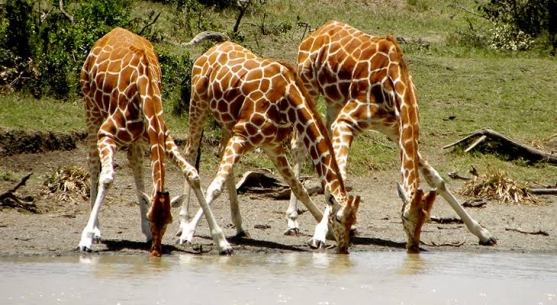
- Name the type of photograph
- Identify what is seen at the fore ground of the photograph.
- With evidence from the photograph suggest the economic activity that might be taking place in the area.
- Mention any three advantages and three disadvantages of the activity mentioned in (c) above.
- The Ilulu girl’s secondary school located at Kilwa – Lindi prepared the questions in advance in which the same questions were asked to all students who attended the school with a need of securing a chance in the academic year 2023 for form one class.
- Identify the type of interview used by Ilulu secondary school.
- Give out four (4) procedures of conducting interview
- Outline two (2) merits and two (2) demerits of the interview method
SECTION C (30 MARKS)
Answertwo(02)questions from this section
- “Despite of the fact that road transport causes a lot of accidents in Tanzania, most Tanzanians
prefer road transport to Air transport”. With six points justify this statement.
- Large population has advantages of having good number of labor force, discuss sixChallenges associated with rapid population increase in the world.
- A Geography teacher at Kutishana Secondary school taught his students that “Soil has physical,chemical and biological properties”. With facts and vivid example, you as an expert in Geography clarify six (6) properties of soil which were taught by Geography teacher at Kutishana Secondary Schoolto his students.
1
FORM FOUR GEOGRAPHY EXAM SERIES 166
FORM FOUR GEOGRAPHY EXAM SERIES 166
THE PRESIDENT’S OFFICE MINISTRY OF EDUCATION, REGIONAL ADMINISTRATION AND LOCAL GOVERNMENT
COMPETENCY BASED SECONDARY EXAMINATION SERIES
GEOGRAPHY-SEPT 2022
FORM FOUR
INSTRUCTIONS
- This paper consists of sections A, B and C with a total of ten (10) question.
- Answer All questions in sections A and B and any two (2) questions from section C.
- Map extract of LINDI is provided
- Cellular phones are NOT allowed in the examination room.
- Write your Examination number on every page of your answer booklet (s)
SECTION A (15 MARKS)
PHYSICAL AND MATHEMATICAL GEOGRAPHY
- For each of the items (i) – (x) choose the correct answer from the given alternatives and write its letter besides the item number.
- The sun is a star of average size and brightness from Earth, the sun appears as round yellow object in the daytime sky. At night we see other stars they appear as tiny points of night. Why does the sun appear large than stars that we see at night?
- Earth’s Atmosphere filters out light from other stars making them appear large
- The sun is close to the earth than other star making the sun appear large
- Star light bend as it pass planets making stars appear smaller
- Day light bend brightness the sun, making it appear larger
- The sun is the planet which follow after the Earth there fore if is very close to it.
- Mrs. Kandonga was shocked the way the earth’s crust shaking resulting to large displacement of materials located on the ground. As a form four students having the knowledge of about the event, what is general statement could you describe the epicenter as source/origin of the shaking of the ground?
- The epicenter is the point on the Earth’s surface just above the location where movement on the fault begin.
- The epicenter is at Caltech in paradena an seismograph are located
- The epicenter is a place on the fault where interests the surface
- The epicenter is the point on the fault’s surface within the Earth where the rapture on the fault begin
- Non above.
- If a geography teachers; Mr. Hassan takes you up to Kilimanjaro Mt. What features would you observe?
- Shield volcano and strato volcano
- Strato volcano and caldera
- Strato volcano and crater
- Dumulo dome and caldera
- Dyke and sills
- The form four students were told by their geography teacher to identify the second layer of the earth’s crust. The response of the students was
- Sial
- Sima
- Mantle
- Core
- Gutenburg gap
- James was given explanation about drainage pattern which looks like a tree with its branches. Which of the following patterns is looking like a tree with its branches?
- Trellised
- Dendritic
- Centripetal
- Radial
- Annular
- If the temperature at 500 metres where the tourists start climbing mount Rugwe is 20°C. What will be the temperature when they reach 2000 meters above sea level?
- 10°C
- 5°C
- 11°C
- 12°C
- 15°C
- If you were a geographer, how could you name the process in which a river renews its erosion in its valley?
- Regime
- Rejuvenation
- Capture
- Cavitation
- Non-of the above.
- If the time at town X 15°E is 12:00 noon, what could be the longitude of 8:00 a.m?
- 15°W
- 30°E
- 45°W
- 30°W
- 45°E
- The Amazon and Congo basine are regions characterized with the same geographical 10 human activities, climate, vegetation and relied. What could be the general term for these regions?
- Natural region
- Natural resources
- Natural vegetation
- Natural landscape
- Natural climate
- Lucia was crossing Rufiji River and accidentally dropped her school bag in the river. Lucia cried as she observed her bag being pulled by the river water the India Ocean. What could the bag named in relation to the river action?
- River erosion
- River transportation
- River load
- River meander
- River bed
- Match the items in List A with responses in List B by writing the letter of the correct response beside the item number in the answer booklet provided.
| LIST A | LIST B |
|
|
SECTION B: (55 Marks)
- Carefully study the map extract of LINDI provided and then answer the following questions
- Convert RF scale given from the map into statement scale.
- A tax driver was moving from Mchinga to Lindi where there is falting station. Find the distance covered in Kilometers
- Calculate the area covered by the forests south of grid line 120.
- With evidences, suggest four economic activities of the people living in the area.
- Giving two evidence from the map. Name the type of climate experienced in this area.
- Carefully study the data in the table below showing importation of motor vehicles from Europe in 2009, and answer the questions that follows:
| Name of vehicle imported | Number of motor vehicle |
| JEEO | 430 |
| BENZ | 192 |
| BMW | 108 |
| RIMOUSSENE | 70 |
- Draw a divided circle to represent the data
- Show three advantages and two disadvantages of the method you have used in (a) above.
- In 2022 form four students from Matemanga secondary school heard about loss of biodiversity existing in Ngorongoro game reserve located at Arusha region Via television and Radio, Geography teacher and reference books from library. They decided to conduct research finally they submitted their report to the head of school.
- Suggest the statement of the problem for their research
- What were the main three (3) objectives of their research?
- Identity two sources of that research problem.
- Elaborate four possible research tools he would use during data collection.
- There was land conflict between two farmers of a certain village in Namtumbo District. The village officers decided to invite a survey team and Cadastral officer to measure and demarcate the boundaries of the two farms. The invited officers decided to use chain/tape surveying to settle the problem.
- Explain three (3), procedures they use during the surveying process.
- Describe (5) instrument they might used in surveying the farmer’s farm.
- Briefly outline the three advantages of the surveying method used above.
- Study the following photograph and answer the questions that follow.
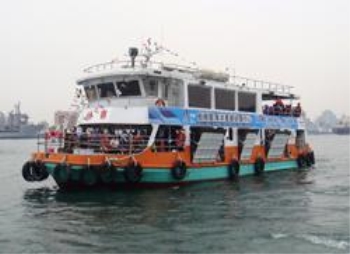
- Identify the type of photograph. Give two reasons to support your answer
- What type of transport is shown in the photograph, and name the kind of vessel shown in the photograph?
- Explain four advantages of transport shown on the photograph
- Identity four main functions of the area.
SECTION C (30 MARKS)
- The government of Tanzania has been struggling to achieve economic development and one of the approach that has been proposing is transport and communication. Explain the significance of transportation in developing in developing countries. Give six points
- When Maganga, a geography teacher was teaching form four students about small scale agriculture, he said “small scale agriculture has been greatly affect bt the rapid population explosion”. As a form four student show how does rapid population explosion affects small scale agriculture.
- From the experience that you have acquired from geographical studies, examine eight factors which lead to the growth of settlement in different parts of the country.
FORM FOUR GEOGRAPHY EXAM SERIES 117
FORM FOUR GEOGRAPHY EXAM SERIES 117
THE UNITED REPUBLIC OF TANZANIA PRESIDENT’S OFFICE
REGIONAL ADMINISTRATION AND LOCAL GOVERNMENT
FORM FOUR GEOGRAPHY MID TERM EXAMINATION-2021
TIME : 3HRS
SECTION A (25 Marks)
1. For each of the following items (i) - (x) choose the correct answer and write its letter beside the number
- Downward or upward movement of the earth’s crust are always given the name as …..
- Internal earths movement ( )
- External earths movements
- Radial movements
- Lateral movements
- ………………………. is a bowl shaped depression at the mouth of a volcano or geyser
- Hot springs
- Lava ( )
- Crater
- Caldera
- Endogenic geomorphic processes includes one among the following.
- Faulting, earthquake, weathering, folding and mass wasting.
- Folding, mass wasting, river action and faulting
- Joints, volcanism, mass wasting and folding. ( )
- Folding, earthquake, faulting and volcanism
- Farmers at Mkombozi village invited Farm officer to give them knowledge on the kind of good soil for growing maize plant. One of the knowledge he provided was about rocks permeability. Assume you are the one invited, what would you tell the farmer about permeability of rock?
- The ability of the rock to hold water.
- The ability of the rock to allow water to pass through.( )
- The rate at which water enter the rock.
- The ability of the rock to allow water to enter it.
- The core comprises mainly of …………………………
- Silica and magnesium
- Silica and aluminum ( )
- Nickel and iron
- Iron and magnesium
- In de jue census, among the following can be done
- People who stay in the house hold for the night are counted
- Is only done after five years
- Only permanent members of the house hold are counted ( )
- I only done after every ten years
- ………………………………. Is a chart used for dating the history of the earth including its rocks?
- Carbon 14
- Periodic table ( )
- Geological time scale
- Measurement chart
- The earth’s sphere where life takes place is called …………………………
- Hydrosphere ( )
- Atmosphere
- Biosphere
- Barrysphere
- A geography teacher was teaching her student that, the earth is inclined in its orbit at which the intensity of sun rays reach different part of the earth varies and cause the earth to experience seasonal weather changes.By relating with the revolution of the earth, what result might occur on the earth?
- Day and night ( )
- Deflection of wind and ocean currents.
- Season of the year.
- High tides and low tides
- John was conducting a research on his first undergraduate degree. Through his research he found that, when someone cross the International Date Line eastward one among the following occur.
- The day become longer than night
- One day is turned back
- Greenwich mean time is recorded
- Time is gained by 4 minutes at every 15 hours ( )
- Match the following items LIST A and that of LIST B
| LIST A | LIST B |
|
|
SECTION B (55 marks)
Answer all questions in this section.
3. Study the map extract of Mpwapwa (sheet 163/4) and answer the following questions.
- At which part of the equator is Mpwapwa located (give one reason)
- Determine the size of the area covered by the forest found between Eastings 150 and 220 and South ofNorthings 900
- What type of vegetation is dominating in the area.
- Suggest four methods used to represent relief features in the mapped area
- Give the bearing of Veternary Research Institute grid reference (224995) to Mpwapwa Teachers Training college grid reference (203978)
- With evidence from the map suggest four social services found aroundgrid reference 218983
- Carefully study the data given on the table below and then answer the questions that follow:
| Class | Frequency |
| 20 - 24 25 - 29 30 - 34 35 - 39 40 - 44 45 - 49 50 - 54 55 - 59 60 - 64 | 3 7 8 12 9 6 4 1 0 |
(a) Find the:-
- Mean
- Mode
- Briefly explain four types of line graph
- (a) The ministry of educationof united republic of Tanzania under National Examination Council past five years, was in research about why there was mass failure of pupils in primary schools. This made the government take sample of schools to make their research. As a student who studied a research topic, give only five reasonwhy the ministry decided to use sample of schools to complete its research?
(b) Briefly explain the following
- Primary data.
- Secondary data.
- (a) Name three kind of obstacles that hinders taking direct measurement during surveying.
(b)Explain five main sources of mistakes during chain survey.
- Study the following photograph and answer the questions that follow.
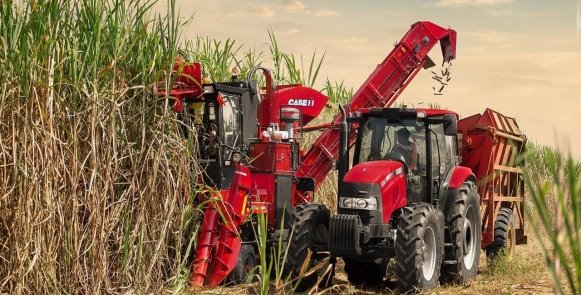
- Name the crop shown on the photograph. (2mark)
- What is the activity taking place on the photograph.(2mark)
- With one evidence, suggest the scale of production of the crop shown. (3marks)
- List down four conditions necessary for the growth of the crop shown on the photograph. (4 marks)
- Outline four factors that might affect the quality of the photograph given. (4marks)
SECTION C (30 Marks)
Answer two questions in this section
- ‘’The ideally census must cover the whole country and all people residing in the country must be counted’’. Suppose you are given a task to educate your society about census. Why would you tell people that, it is very important for Tanzanian government to conduct census?(Explain five reasons).
- Plantation is the most form of agriculture practiced in tropical region of Africa, Asia and South America. Justify six characteristics of plantations practiced in these areas.
- Discuss six efforts that Tanzania must adopt to make tourism industry very potential for our national development.
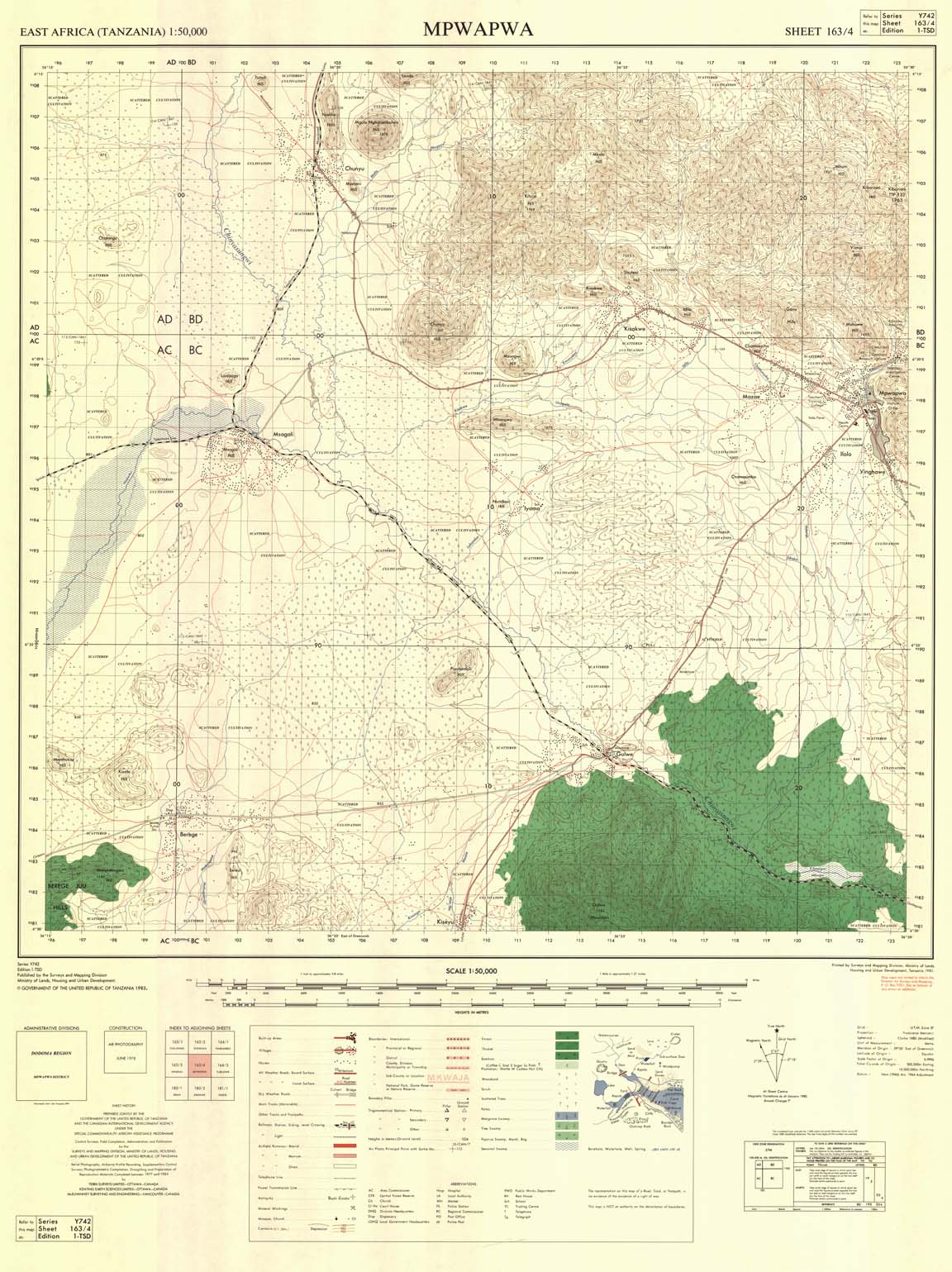 |
FORM FOUR GEOGRAPHY EXAM SERIES 70
FORM FOUR GEOGRAPHY EXAM SERIES 70
THE PRESIDENT’S OFFICE
MINISTRY OF EDUCATION, REGIONAL ADMINISTRATION AND LOCAL GOVERNMENT
SECONDARY EXAMINATION SERIES
GEOGRAPHY MID TERM EXAMINATION
FORM FOUR- AUG/SEPT -2021
Time: 3Hours
Instructions.
- This paper consists of section A, B and C with a total of 10 questions
- Answer all questions in section A and B and two questions from section C.
- Section A carries 15 marks, section B 55 marks and section C 30 MARKS
- Map extract sheet for Kigoma sheet 92/3 is provided.
- Programmable calculators, cellular phones and any other unauthorized materials are not allowed in examination room.
- Write your number on every page of your answer booklet.
SECTION A (15 Marks)
Answer All questions in this section.
(i)The intensity of an earthquake is measured by an instrument called:
A. epicentre
B.chronometer
C. seismography
D. Richter scale
E. hygrometer
(ii)Tides are highest:
A.during the eclipse
B.during the aphelion
C.during the equinox
D.during the day and night throughout the year
E.at the poles
(iii)Which one among the following features occurs in a glaciated lowland region?
- Esker
- Cirque
- Pyramidal peak
- Hanging valley
- Arete
(iv)Plants with long roots, thorny stems, needle shaped leaves, wax or hair are found in:
- the Mediterranean region
- hot deserts
- tropical grasslands
- the equatorial region
- the monsoon region
(v) The magnitude of an earthquake refers to:
- effects produced by the earthquake
- large amplitude waves known as L-waves
- point at which earthquake originates
- total amount of energy released
- point on the earth surface above the focus
(vi) When two forces act away from each laterally, they are called
- lateral forces
- orogenic forces
- vertical forces
- compressional forces
- tensional forces.
(vii) The earth’s shape is a flattened sphere which is called
- ekman spiral
- geoid
- globe
- galtax
- spherical.
(viii)Which of the following types of lakes does not occur from depositional factor?
- Playa
- Tarn
- Ox-bow
- Delta
- Lagoon
(ix)The name given to a boundary that demarcates solid materials from the molten mantle is:
- asthenosphere
- Gutenberg
- mohorovic
- mesosphere
- core
(x)The crust is sometimes referred to as:
- lithosphere
- hydrosphere
- troposphere
- mesosphere
- tropopause
2, Match the responses in LIST B with the phrases inLIST Aby writing the letter of the correct response beside the item number.
| LIST A | LIST B |
| (i)Are lines of glacial deposits along the sides of valleys (ii)A tidal formed as a result of an earthquake or volcanic eruption (iii)Small particles of condensed water at the lower part of the atmosphere (iv)Winds blowing from horse latitudes to the Equatorial belts (v)A well developed surface of a limes one region |
|
SECTION B (55 Marks)
Answer all questions in this section.
3. Study the map extract of Kigoma sheet 92/3 and answer the following questions.
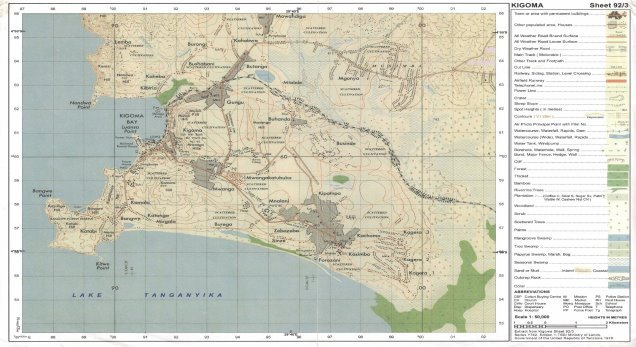
(a) Outline the importance of scale in a map.
(b) Measure the distance of the railway line.
(c) Calculate the area of Lake Tanganyika.
(d) What factors have influenced the location of Kigoma town?
(e) Explain the main socio-economic activities carried out in the area.
3. The data below show the enrolment of Form Five students at Kilimo Secondary School from 1980 - 1985.
|
| 1980 | 1981 | 1982 | 1983 | 1984 | 1985 |
| No. of Students | 100 | 150 | 175 | 200 | 225 | 300 |
(a)Present the data by divergent bar graph.
(b)What are the advantages and disadvantages of this method?
(c) Name three alternative ways of presenting the data.
5. Giving examples, explain how you can conduct a field research.
6.(a) Define the term rock
(b) Give economic importance of rock
7. Study carefully the photograph provided and answer the following questions:
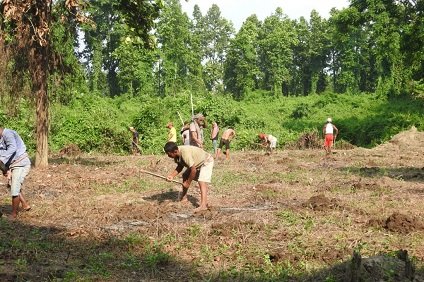
(a) Explain the traditional methods used for clearing the vegetation as seen in the photograph.
(b) State the type of vegetation found in the area.
(c) What are the impacts over the environment of this activity at the local and national level?
(d) Determine the weather condition at the time the photograph was taken.
SECTION C (30 Marks)
Answer two (2) questions from this section.
8. Describe six contributions of cash crops production ot the economy of United States of America.
9. “Agriculture achievements in China have been brought about by good Government policy only.” Discuss.
10. Explain the factors that influence the exploitation of mineral resources.
FORM FOUR GEOGRAPHY EXAM SERIES 60
FORM FOUR GEOGRAPHY EXAM SERIES 60
THE PRESIDENT'S OFFICE
MINISTRY OF REGIONAL GOVERNMENT AND LOCAL GOVERNMENT
PRE-NATIONAL EXAMINATION SERIES-1
GEOGRAPHY FORM-4
2020
TIME: 3:00 HRS
Instructions
- This paper consists of sections A, B and C with a total of ten (10) questions.
- Answer all questions in sections A and B and any two (2) questions from section C.
- Map extract of Mkomazi (Sheet 109/1) is provided.
- Programmable calculators, cellular phones and unauthorised materials are not allowed in the examination room.
- Write your Examination Number on every page of your answer booklet(s).
SECTION A (15 Marks)
Answer all questions in this section.
1. For each of the items (i) — (x), choose the correct answer from among the given alternatives and write its letter besides the item number in the answer booklet provided.
(i) Which of the following layers of the earths interior is made up of sima and sial?
- Biosphere
- Hydrosphere
- Asthenosphere
- Lithosphere
- Barysphere
(ii) Senegal National team scored a goal at 2:00 pm in Senegal (1500 W). At what time at Burundi (300 E) the goal was scored?
- 2:00 am
- 10:00 am
- 4:00 am
- 10:00 pm
- 12:00 am
(iii) Which of the following is the process of wearing down the rock surface by wind where the load becomes cutting tools?
- Deflation
- Attrition
- Abrasion
- Corrasion
- Hydration.
(iv) The renewed power of erosion of a river is called.
- river capture
- river erosion
- river rejuvenation
- river meanders
- river basin.
(v)Prediction of the state of atmosphere in a region for 24 to 48 hours is known as
- weather elements
- weather report
- weather instrument
- weather station
- weather forecasting
(vi) Deposition of soil materials removed from one horizon to another is called
- Convex sided
- Concave sided
- Gentle sided resistance
- Steep sided resistant
- Steep sided non resistance.
(vii) The excessive strong wind blowing across an extensive ocean surface is called
- Tsunami
- Ocean currents
- Storm s urge
- Hurricane
- Wind.
(viii) Rainfall that occurs when the air moves towards a hill or a mountain is called
- cyclonic
- orographic
- convectional
- showers
- typhoon.
(ix) An active state of decomposition caused by soil microorganism is called
- organic matter
- soil water
- mineral matter
- soil air
- soil components.
(x) The name given to earthquake waves that travel within a crust is
- focus
- epicentre
- seismic
- surface waves
- body waves.
2. Match the items in List A with the responses in List B by writing the letter of the correct response beside the item number in the answer booklet provided.
| LIST A | LIST B |
| (i) A mass of magma which has emerged on the earth’s surface. (ii) A wall like feature formed when magma cuts across a bedding plane. (iii) A sheet of magma which lies along a bedding plane. (iv) A very large mass of magma which often forms the root of a mountain. (v) A dome-shaped feature formed when magma push up the overlaying layers. |
|
SECTION B (55 Marks)
Answer all questions in this section.
3. Study the map extract of Mkomazi (Sheet 109/1) and then answer the following questions:
- By using the given RF scale, measure the distance of river Pangani in kilometres from grid reference 910771 to 910826.
b. Describe relief of the area.
c. With reasons, identify two types of rocks found in the map.
d. Name the major way used to show the height of the land in the mapped area.
e.Using a vertical scale of lcm to represent 50m, draw an annotated cross section from grid reference 960820 to 910880 and mark Ruvu river basin and the main trucks.
4. (a) Explain the meaning of the standard deviation.
(b) Study the following data showing the age of the Primary School pupils at Tumaini Primary School and answer the questions that follow: 15, 8, 7, 6, 12, 5, 14 and 13.
(i) Determine the range and median of the age of the pupils.
(ii) Calculate the standard deviation.
5. Form three students at Nguvumali secondary school would like to conduct a simple chain survey around their school compound and measure the height of the big gully near the headmaster’s office. Describe the significance of survey in Tanzania
6. (a) What is meant by sampling techniques as used in research?
(b) Briefly explain the following concepts as they are applied in sampling:
(i) A sample
(ii) Random sampling
(iii) Systematic sampling
(iv) Stratified sampling
(c) Outline the procedures of conducting an interview.
7. Study the photograph given below and then answer the questions that follow:
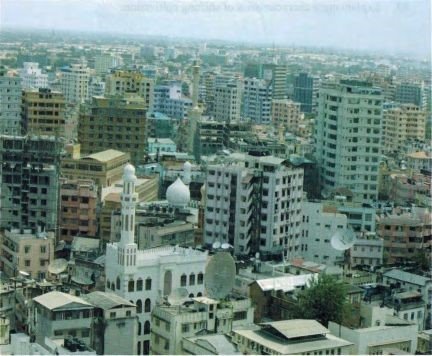
(a) With two reasons, identify the type of the photograph.
(b) Identify the type of the settlement pattern seen on the photograph.
(c) Name two economic importances of the area shown on the photograph.
(d) Explain two social and environmental problems that are likely to occur in the area.
SECTION C (30 Marks)
Answer two (2) questions from this section.
8. Describe seven problems associated with rapid urbanization.
9. Describe five measures to control floods to the environment.
10. Analyse six potentials of the Rufiji river basin.
FORM FOUR GEOGRAPHY EXAM SERIES 31
FORM FOUR GEOGRAPHY EXAM SERIES 31
Hub App
 For Call,Sms&WhatsApp: 255769929722 / 255754805256
For Call,Sms&WhatsApp: 255769929722 / 255754805256
 For Call,Sms&WhatsApp: 255769929722 / 255754805256
For Call,Sms&WhatsApp: 255769929722 / 255754805256







